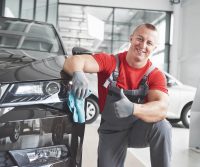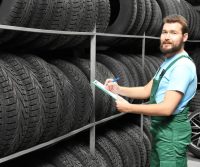
Road Trip Vehicle Checklist
Road trips are an adventure and a fantastic way to explore new destinations. However, the key to a successful and stress-free journey lies in preparation, particularly when it comes to your vehicle. At Auto Clinic of Franklin, we emphasize the importance of a comprehensive vehicle check to ensure your safety and comfort on the road. This blog post will guide you through a detailed vehicle checklist to prepare for your next road trip.
Essential Vehicle Checklist for Road Trips
Tires: Pressure and Tread Wear
- Check tire pressure to ensure it aligns with the manufacturer’s recommendations, adjusting for load and temperature changes.
- Inspect the tread for signs of uneven wear or damage, and replace any tires that do not meet safety standards.
Brakes: Pads and Fluid
- Ensure your brake pads are not worn down and that there’s no squeaking or grinding noise when braking.
- Check the brake fluid level and look for signs of leaks in the brake system.
Battery: Charge and Connections
- Test the battery to make sure it holds a charge, especially if it’s over three years old.
- Clean any corrosion from terminals and ensure the connections are tight and secure.
Fluids: Oil, Coolant, and Transmission
- Change the oil if you’re near the recommended oil change interval.
- Ensure the coolant level is appropriate to avoid overheating and check for any leaks in the system.
- Verify that the transmission fluid is at the correct level and consider a flush if it’s been a while or if the fluid is dark and dirty.
Lights and Signals
- Check all exterior lights—headlights, tail lights, brake lights, and turn signals—to ensure they are functioning properly and are visible.
Air Conditioning and Heating
- Test your vehicle’s HVAC system to ensure the air conditioning and heating are functioning correctly, as comfort is crucial during a long drive.
Wipers and Washer Fluid
- Replace any worn wiper blades and fill up the windshield washer reservoir.
Belts and Hoses
- Inspect belts and hoses for any signs of wear or cracks. Listen for any unusual sounds when the engine is running that might indicate a loose belt.
Emergency Kit
- Pack an emergency kit that includes a first aid kit, flashlight, basic tools, extra coolant and oil, a tire inflator and sealer, and jumper cables.
Planning Your Route and Stops
Besides checking your vehicle, planning your route and potential stops in advance can make your road trip smoother. Consider traffic patterns, weather conditions, and available rest stops to maximize your safety and enjoyment.
Conclusion
A well-prepared vehicle is the foundation of any great road trip. By following this checklist, you can address any issues before they become problematic, ensuring a safe and enjoyable journey. At Auto Clinic of Franklin, we are here to help you get your vehicle road trip ready.
Call to Action Don’t leave your road trip to chance. Fill out the form below to schedule a comprehensive vehicle inspection at Auto Clinic of Franklin today, and hit the road with confidence!
Contact us

Seasonal Vehicle Maintenance
Every season brings a unique set of challenges for vehicle maintenance. From the sweltering heat of summer to the icy conditions of winter, seasonal changes demand attention to ensure your vehicle performs optimally and remains in good condition. At Auto Clinic of Franklin, we’re committed to helping you navigate these changes, ensuring your car is ready for whatever the weather throws its way.
Understanding the Seasonal Demands on Vehicles
The impact of seasonal changes on your vehicle is significant. Each season affects various components of your vehicle differently, requiring specific attention to detail and preventative measures to avoid common issues.
Spring: The Time for Renewal
- Check and Replace Fluids: Winter can be harsh on your vehicle’s fluids. Spring is the perfect time to check and replace them, including the engine oil, coolant, and brake fluid.
- Tire Maintenance: Fluctuating temperatures can affect tire pressure. Ensure your tires are properly inflated and aligned to avoid uneven wear.
Summer: Preparing for the Heat
- Air Conditioning Check: Before the peak of summer, ensure your air conditioning system is functioning efficiently to keep you cool and comfortable.
- Battery Maintenance: High temperatures can shorten a battery’s life. Test your battery and replace it if necessary to avoid breakdowns during hot days.
Fall: Getting Ready for the Cooler Months
- Brake Inspection: As leaves and rain can make roads slippery, ensuring your brakes are in top condition is crucial for safe driving.
- Lighting Check: With the days getting shorter, good lighting is essential. Check all your lights and replace any that are dimming or burnt out.
Winter: Battling the Cold and Ice
- Antifreeze Levels: Antifreeze is vital in preventing your engine from freezing. Check the levels and the mixture to ensure optimal protection.
- Heater and Defroster Performance: Comfort and visibility during winter depend on an effective heating system and a working defroster.
Why Seasonal Maintenance Matters
Regular maintenance as the seasons change not only extends the lifespan of your vehicle but also ensures safety on the road. It prevents minor issues from becoming major repairs and helps maintain the vehicle’s performance and fuel efficiency.
Conclusion
The impact of seasonal changes on your vehicle should never be underestimated. With the right care and attention, you can protect your investment and enjoy a safer, more reliable drive no matter the season. At Auto Clinic of Franklin, our expert team is here to assist you with comprehensive seasonal maintenance services tailored to your vehicle’s needs.
Is your vehicle ready for the changing seasons? Fill out the form below to schedule a seasonal maintenance check with Auto Clinic of Franklin. Let us help you keep your vehicle in peak condition all year round!
Contact us

Auto Repair Shop Franklin
Finding a reliable auto repair shop is crucial for maintaining your vehicle’s health and ensuring your safety on the road. With countless options available, how do you choose the right one? Here’s a comprehensive guide to help you make an informed decision when selecting an auto repair shop.
1. Check for Certifications
Certifications are a good indicator of professionalism and the technical expertise of the staff. Look for shops that display certifications like ASE (Automotive Service Excellence) or are affiliated with reputable organizations such as the AAA (American Automobile Association). These certifications mean that the technicians are trained to handle a wide range of automotive problems effectively.
2. Look at Reviews and Reputation
In today’s digital age, customer reviews are invaluable. Check platforms like Google, Yelp, and social media to see what other customers are saying about their experiences. Pay attention to both positive and negative reviews to gauge the shop’s reputation. A consistent pattern of positive reviews is a good sign of reliability and quality service.
3. Experience with Your Vehicle Type
Some shops specialize in specific types of vehicles or services. Ensure the shop you choose has experience with your car’s make and model. This specialization can provide you with more accurate diagnostics and better-quality repairs, as the mechanics are likely to be more familiar with the intricacies of your specific vehicle.
4. Transparent Pricing
Before you commit to a repair, ask for an estimate. Reliable shops will offer transparent pricing and will explain what the repair involves and why it is necessary. Be wary of shops that are not willing to provide clear explanations or that seem to add unnecessary services.
5. Warranty on Repairs
A trustworthy auto repair shop will stand behind their work. Ask about the warranty on the repairs they offer. A good warranty policy covers both parts and labor, which gives you peace of mind that the shop is committed to providing quality service.
6. Convenient Location and Friendly Service
The convenience of location can make a big difference, especially if you need to leave your car at the shop for repairs. Additionally, note how the staff interacts with you. Friendly, courteous, and professional interactions are key indicators of a business that values customer service and satisfaction.
7. Ask for Recommendations
Word of mouth remains a powerful tool. Ask friends, family, and colleagues where they take their vehicles for repairs. Personal recommendations can lead you to trustworthy mechanics who have proven their ability to deliver satisfactory services.
Conclusion
Choosing the right auto repair shop is about more than just finding a place that can fix your car. It’s about finding a place you can trust to provide honest service and professional advice. At Auto Clinic of Franklin, we pride ourselves on our certified technicians, transparent pricing, and excellent customer service. Visit us today to experience top-notch auto repair services tailored to your needs.
Need Professional Auto Repair Services?
Fill out our form below to get a personalized quote or schedule a consultation with one of our expert mechanics at Auto Clinic of Franklin. Let us treat your vehicle with the professionalism and expertise it deserves.

DIY Car Care
Maintaining your car is essential for ensuring its longevity and optimal performance. While some tasks require professional attention, there are several maintenance activities you can perform at home to keep your vehicle in top shape. At Auto Clinic of Franklin, we encourage drivers to understand and be involved in their car’s upkeep. Here are some simple DIY car care tasks that you can easily handle on your own.
1. Checking and Changing Engine Oil
Regularly checking and changing your car’s engine oil is crucial for keeping the engine running smoothly. You’ll need to check the oil level every few weeks and change it as recommended in your car’s manual—typically every 3,000 to 5,000 miles. Make sure the car is parked on level ground when checking the oil to get an accurate reading.
2. Replacing Windshield Wipers
Windshield wipers are vital for your safety on the road, ensuring clear visibility during rain or snow. Over time, wipers can become worn and less effective. Thankfully, replacing them is a simple task that doesn’t require any tools. Most wiper blades can be changed by unhooking the old ones and snapping on the new ones, following the instructions on the package.
3. Checking Tire Pressure and Tread
Maintaining correct tire pressure ensures better fuel efficiency and safer driving. Check your tire pressure monthly using a tire pressure gauge. Make sure to also check the tread for wear and tear. You can use the penny test: place a penny into the tread with Lincoln’s head upside down; if you can see all of Lincoln’s head, it’s time to replace the tire.
4. Replacing Air Filters
Your car’s air filter prevents dirt and debris from entering the engine and should be replaced approximately every 12,000 to 15,000 miles. Replacing an air filter is straightforward: locate the filter under the hood (check your manual for exact location), remove the old filter, and insert the new one.
5. Cleaning Battery Connections
A dirty or corroded battery connection can lead to starting problems. To clean your battery terminals, first ensure your car is off. Remove the battery terminals, starting with the negative before the positive. Clean each terminal with a brush and a mixture of baking soda and water, then rinse and dry before reconnecting, starting with the positive.
6. Inspecting Belts and Hoses
Check belts and hoses for cracks, wear, and leaks, especially before a long trip. While replacing them might require more skill, inspecting them is easy. Look for any visible signs of deterioration or listen for a squealing noise when the car is running, which could indicate a loose or worn belt.
Conclusion
Regular maintenance is key to car care, and handling these simple tasks at home can save you time and money. However, for more complex issues or if you’re unsure about a particular maintenance task, it’s wise to seek professional help.
Looking for professional advice or need assistance with more complex vehicle maintenance? Fill out the form below to contact Auto Clinic of Franklin today, and let our experts help you keep your car in perfect condition.
Contact us

Regular Vehicle Inspections
Regular vehicle inspections are not just a formality—they are a fundamental aspect of car ownership that significantly enhances safety on the road. At Auto Clinic of Franklin, we emphasize the importance of routine inspections to ensure that your vehicle meets legal standards and operates at its best, providing you and your family with a safe driving experience. From a safety perspective, here’s a look at the key benefits of regular vehicle inspections.
1. Preventing Malfunctions on the Road
One of the primary benefits of regular vehicle inspections is the early detection of potential mechanical issues that could lead to breakdowns. During an inspection, mechanics check critical components like brakes, tires, lights, and engine performance to ensure everything is in good working order. Catching issues early can prevent the inconvenience and potential danger of a vehicle malfunction while driving, such as brake failure or a blown tire.
2. Enhancing Vehicle Performance and Reliability
Regular inspections help maintain optimal vehicle performance. Your car runs more efficiently when the engine, transmission, and exhaust system are checked and serviced regularly. This reliability can significantly affect your vehicle’s handling, fuel economy, and overall performance, ensuring a smoother, safer drive.
3. Extending the Life of Your Vehicle
Regular inspections can extend the life of your vehicle by identifying and addressing minor issues before they become major problems. This is economically beneficial and contributes to safety, as well-maintained vehicles are less likely to encounter severe mechanical failures that could compromise driver safety.
4. Ensuring Compliance with Safety Regulations
Regular vehicle inspections ensure your car complies with state and federal safety regulations. This is particularly important as these regulations are designed to protect you and other road users by ensuring that all vehicles meet minimum safety standards.
5. Increasing Resale Value
A well-maintained vehicle with a history of regular inspections and services is more attractive to potential buyers. Should you decide to sell your car, its superior condition, assured through consistent maintenance checks, can significantly increase its resale value.
6. Reducing Costs Over Time
Although regular inspections involve some upfront costs, they can save you money in the long run by avoiding more expensive repairs that result from neglect. For example, replacing worn brake pads during a routine inspection is much less expensive than repairing the additional damage that might occur to the brake discs if the worn pads are not addressed in time.
How Auto Clinic of Franklin Can Help
At Auto Clinic of Franklin, we provide thorough vehicle inspections and maintenance services designed to address your car’s needs and ensure your safety on the road. Our team of certified mechanics uses the latest diagnostic equipment to assess your vehicle’s condition and perform necessary repairs or maintenance.
Contact Auto Clinic of Franklin today to schedule your next vehicle inspection. Let us help you keep your car in optimal condition, enhancing your safety and the safety of others on the road. Regular vehicle inspections invest in your vehicle’s health and peace of mind as a driver.
Contact us

Safe Driving Tips Franklin
Driving in Franklin, with its bustling intersections and scenic backroads, can be a pleasure. However, like any other city, navigating the roads safely requires knowledge, preparedness, and a proactive approach to driving. At Auto Clinic of Franklin, we are committed to helping our community drive safely and efficiently. Here are some essential tips to help you navigate Franklin’s roads with confidence and ensure your safety and that of others on the road.
1. Understand the Layout of Franklin
Franklin features a mix of historic areas with narrow streets and modern roadways. Familiarize yourself with the road layout, especially if you are new to the area. Utilize GPS navigation but remain alert to real-time road conditions and traffic updates. Be mindful of one-way streets in the downtown area to avoid confusion and potential accidents.
2. Adapt to Local Weather Conditions
Franklin experiences a range of weather conditions that can impact driving safety. During heavy rain, reduce your speed to counteract slippery roads and increased stopping distances. In winter, watch for ice patches, especially on bridges and overpasses that tend to freeze first. Adjusting your driving according to weather conditions is crucial for safe navigation.
3. Respect Traffic Laws and Speed Limits
Observe all traffic laws and adhere to posted speed limits. The roads in Franklin can be winding, and speed limits are set not just for legal compliance but for your safety considering road curvature and visibility. Areas near schools and parks have reduced speed limits to protect pedestrians, particularly children, so extra caution is necessary.
4. Stay Alert at Intersections
Intersections can be hotspots for accidents, especially during peak hours. Always approach intersections with caution, use turn signals well in advance, and be prepared to stop if the traffic situation changes. Watch for pedestrians and cyclists, and always check for vehicles in your blind spots before turning or changing lanes.
5. Maintain Your Vehicle
Regular vehicle maintenance isn’t just about vehicle longevity but also safety. Ensure that your brakes, lights, tires, and windshield wipers are in good working condition to handle any unexpected situations on the road. Auto Clinic of Franklin offers comprehensive check-ups and maintenance services to keep your car safe and roadworthy.
6. Practice Defensive Driving
Defensive driving involves being vigilant, ready to react to others’ actions. Keep a safe following distance, anticipate the actions of other drivers, and stay focused on the road. Avoid distractions like using your phone or other electronic devices while driving.
7. Know What to Do in an Accident
Despite all precautions, accidents can happen. Always carry your insurance information and a roadside emergency kit in your vehicle. If you are involved in an accident, check for injuries, move to a safe location if possible, and call emergency services. Then, document the accident scene and exchange information with the other driver.
Let Auto Clinic of Franklin Help Keep You Safe
Your safety on the road is our priority at Auto Clinic of Franklin. Whether you need routine maintenance to ensure your vehicle is in top condition or require repairs after an incident, our team of experienced technicians is here to help.
Contact Auto Clinic of Franklin today to schedule a service or to get more tips on safe driving practices in Franklin. Drive safely and confidently, knowing that you are taking the right steps to protect yourself and your loved ones on the road.
Contact us

Understanding Tire Wear
Tires are the only point of contact your vehicle has with the road, making them one of the most critical components for your safety and driving performance. However, tires don’t last forever. Understanding the factors that contribute to tire wear and how to mitigate them can significantly extend the life of your tires, saving you money and keeping you safer on the road. Here, we’ll dive into the essentials of tire maintenance and provide practical tips for maximizing tire longevity. Plus, discover how Auto Clinic of Franklin can assist you in keeping your tires in top condition.
Key Factors Contributing to Tire Wear
- Improper Inflation: Tires inflated below or above the manufacturer’s recommended levels can lead to uneven wear, reduced fuel efficiency, and even blowouts.
- Misalignment: When your vehicle’s wheels are not aligned correctly, it can cause uneven wear on your tires, leading to premature replacement.
- Driving Habits: Aggressive driving, such as hard braking, fast acceleration, and sharp turns, can wear down tires more quickly.
- Lack of Rotation: Tires wear unevenly due to their position on the vehicle. Regular rotation helps distribute wear more evenly, extending tire life.
Tips for Extending Tire Life
- Maintain Proper Tire Pressure: Check your tire pressure monthly and before long trips. Inflate your tires to the recommended pressure listed in your vehicle’s manual or on the sticker inside the driver’s door.
- Regular Tire Rotation: Have your tires rotated every 5,000 to 7,500 miles to promote even tire wear. This is often done during oil change appointments for convenience.
- Align Your Wheels: Get your vehicle’s alignment checked annually or if you notice uneven tire wear, your vehicle pulling to one side, or steering wheel vibration.
- Balance Your Tires: Ensuring your tires are balanced correctly can prevent uneven wear and extend tire life. Have them checked with every rotation.
- Drive Mindfully: Avoid fast starts, stops, and turns. Be cautious of potholes and road debris. Gentle driving can significantly reduce tire wear.
- Inspect Tires Regularly: Check for signs of wear, damage, or foreign objects lodged in the tread. Early detection of issues can prevent further damage.
How Auto Clinic of Franklin Can Help
At Auto Clinic of Franklin, we’re committed to helping you get the most out of your tires. Our comprehensive tire services include pressure checks, rotation, alignment, balancing, and inspections. Our experts can advise you on the best practices for tire care and recommend when it’s time for replacements, ensuring your safety and extending the life of your tires.
Schedule Your Tire Service with Auto Clinic of Franklin Today. Don’t let worn tires put you at risk or force you into premature purchases. Let Auto Clinic of Franklin help you maximize the life of your tires with our expert services. Proper tire maintenance is not just about extending the life of your tires—it’s about ensuring your safety and the safety of others on the road—Trust Auto Clinic of Franklin to keep your vehicle running smoothly and your tires wearing evenly.
By understanding the factors that contribute to tire wear and taking proactive steps to counteract them, you can significantly extend the life of your tires. With the support of Auto Clinic of Franklin, maintaining your tires has never been easier. Reach out to us today to keep your tires in peak condition and enjoy a safer, smoother driving experience.
Contact us

Maintaining a vehicle involves various tasks, but one of the simplest and most crucial tasks is the regular changing of its oil. This fundamental aspect of car maintenance ensures your engine runs smoothly and plays a pivotal role in preventing costly repairs down the line. With Regular Oil Changes, it has never been easier to ensure your vehicle receives timely oil changes. Let’s delve into why regular oil changes are essential and what you need to know to keep your car in top condition.
Why Regular Oil Changes Are Critical
1. Engine Lubrication: The primary function of motor oil is to lubricate the moving parts of your engine, preventing them from grinding against each other. Regular oil changes ensure these components remain well-lubricated and operate smoothly, reducing wear and tear.
2. Cooling Engine Components: Friction generates heat, but fresh oil helps dissipate this heat evenly throughout the engine. Without regular oil changes, your engine could overheat, leading to serious damage.
3. Removing Engine Wear Particles and Sludge: Over time, oil breaks down and gets contaminated with dirt, debris, and metal particles, transforming into sludge. Regular oil changes help to remove these contaminants, keeping your engine clean and running efficiently.
4. Improving Gas Mileage: A well-lubricated engine runs more smoothly and efficiently, which can improve your fuel economy. According to the U.S. Department of Energy, regular oil changes can lead to a 1-2% improvement in gas mileage, which adds up over time.
5. Extending Engine Life: Regular maintenance, including oil changes, is the most straightforward method to extend the life of your vehicle. Clean oil ensures that your engine operates under optimal conditions, reducing the likelihood of premature breakdowns and extending the lifespan of your car.
How Often Should You Change Your Oil?
In the past, changing the oil every 3,000 miles was suggested. However, due to the advancements in engine and oil technologies, most modern vehicles can now go between 5,000 and 7,500 miles between oil changes. Some vehicles that have synthetic oil can even go 10,000 miles or more. It’s important to refer to your car’s owner’s manual or consult a professional at Regular Oil Changes to determine the recommended oil change interval that suits your vehicle and driving conditions.
Why Choose Regular Oil Changes for Your Oil Change?
At Regular Oil Changes, we understand the importance of maintaining your vehicle’s health for its longevity and your safety. Our team of certified professionals uses high-quality oils and filters tailored to meet the specific needs of your vehicle. We offer:
- Expertise: Our knowledgeable technicians provide top-tier service and can help you understand your vehicle’s specific needs.
- Convenience: With easy scheduling and prompt service, we ensure that getting your oil changed is as hassle-free as possible.
- Transparency: We explain the process and offer straightforward pricing without upselling unnecessary services.
Ready for Your Next Oil Change?
Regular oil changes are a simple yet crucial part of maintaining your vehicle’s health. With Regular Oil Changes, you’re not just getting an oil change; you’re investing in your vehicle’s longevity and performance.
Schedule your next oil change with Regular Oil Changes today and ensure your vehicle continues to run smoothly and efficiently. Keep your engine protected and extend its life with our expert service. Drive with confidence, knowing that Regular Oil Changes has you covered for all your vehicle maintenance needs.
Contact us

Fuel Efficiency Tips
In an era where environmental sustainability intersects with the practical need to save money, maximizing your vehicle’s fuel efficiency is more important than ever. Whether you’re concerned about your carbon footprint or looking to reduce your fuel expenses, adopting smart driving habits and adhering to a strict car care routine can make a significant difference. This blog post explores actionable strategies for enhancing your car’s fuel efficiency through mindful driving and maintenance practices. Plus, find out how Auto Clinic of Franklin can support your journey toward a more fuel-efficient and environmentally friendly driving experience.
Smart Driving Habits for Better Fuel Economy
1. Steady Speeds Over Speeding: Maintaining a consistent speed, especially on highways, can improve your vehicle’s fuel efficiency. Use cruise control when possible to help maintain a steady speed and reduce fuel consumption.
2. Avoid Unnecessary Idling: Idling gets 0 miles per gallon. Minimizing idle time not only conserves fuel but also contributes to reducing overall emissions. Turn off your engine when your vehicle is parked for more than a minute.
3. Accelerate and Brake Smoothly: Sudden starts and stops can increase fuel consumption. Accelerate gradually and allow your car to coast to a stop whenever possible to save fuel.
4. Reduce Excess Weight: Extra weight in your vehicle makes the engine work harder and consume more fuel. Regularly clean out your car and remove unnecessary items from the trunk.
5. Use Air Conditioning Sparingly: Running the A/C on high can reduce your car’s fuel efficiency. Use it conservatively, and consider opening the windows when driving at lower speeds.
Car Care Tips for Maximizing Fuel Efficiency
1. Regular Maintenance: Follow your vehicle’s maintenance schedule for oil changes, filter replacements, and other services. Well-maintained vehicles run more efficiently and have better fuel economy.
2. Check Tire Pressure: Under-inflated tires can lead to higher fuel consumption because more energy is required to move your vehicle. Check your tire pressure regularly and inflate your tires to the recommended level.
3. Use the Recommended Grade of Motor Oil: Using the manufacturer’s recommended grade of motor oil can improve your car’s fuel efficiency by 1-2%. Check your owner’s manual for recommendations.
4. Keep Your Engine Tuned: A well-tuned engine operates at peak performance and maximizes fuel efficiency. Address engine performance issues, such as a rough idle or misfiring spark plugs, promptly.
5. Consider Aerodynamics: Roof racks and carriers increase wind resistance and fuel consumption. Remove them when not in use to improve your vehicle’s aerodynamics and fuel efficiency.
How Auto Clinic of Franklin Can Help
At Auto Clinic of Franklin, we understand the importance of maximizing your vehicle’s fuel efficiency for both the environment and your wallet. Our comprehensive car care services are designed to keep your vehicle running at its best, ensuring optimal fuel efficiency. From regular maintenance to tire pressure checks and engine tuning, our expert team is here to help you adopt the best practices for a more fuel-efficient driving experience.
Contact Auto Clinic of Franklin Today to schedule your next service appointment. Let us assist you in making your vehicle more fuel-efficient with our professional car care services. Together, we can make a difference in your driving habits and contribute to a healthier planet.
Embracing smart driving habits and diligent car care are key steps towards improving your vehicle’s fuel efficiency. With the support of Auto Clinic of Franklin, you can enjoy a smoother, more eco-friendly, and cost-effective driving experience. Reach out to us today and take the first step towards maximizing your car’s fuel efficiency.
Contact us

Winter Car Preparation
As the temperature drops and the leaves start to fall, it’s a clear sign that winter is on its way. This season can be particularly challenging for your vehicle, with cold temperatures, icy roads, and snow all posing potential hazards. However, with the right preparation, you can ensure that your vehicle remains safe and reliable throughout these colder months. Here at Auto Clinic of Franklin, we believe in proactive car care, and we’re here to guide you through getting your vehicle winter-ready.
Check Your Battery
Cold weather can be tough on your car’s battery. The lower temperatures reduce its capacity and can leave you stranded with a no-start condition on the coldest days. Have your battery tested to ensure it has enough life left to last the winter. If it’s nearing the end of its lifespan, consider replacing it to avoid any mid-winter mishaps.
Inspect Your Tires
Your tires are the only point of contact between your vehicle and the road, making them crucial for winter safety. Check the tread depth to ensure you have enough grip to handle icy and snowy roads. If you live in an area with heavy snowfall, consider investing in a set of winter tires for improved traction.
Refill or Replace Fluids
Ensure your vehicle’s fluids are topped up and ready for the winter. This includes the antifreeze, which keeps your engine from freezing in cold temperatures, and windshield washer fluid with a lower freezing point to keep your visibility clear. Also, make sure your oil change is up to date, as colder temperatures can affect the viscosity and performance of your engine oil.
Lights and Wipers
Shorter days and inclement weather mean your vehicle’s lights and wipers play a more significant role in winter. Check all your lights to ensure they work correctly, and replace any burnt-out bulbs. Consider upgrading to winter wiper blades and using windshield fluid rated for freezing temperatures to enhance visibility during snow and sleet.
Emergency Kit
Lastly, prepare an emergency kit specifically for winter. This should include items like blankets, a flashlight, a first-aid kit, a portable charger, water, and non-perishable snacks. Additionally, consider adding a snow brush, ice scraper, and a bag of sand or cat litter to help with traction in case you get stuck.
Ready for Winter?
Don’t wait for the first frost to think about winterizing your vehicle. Taking these steps early can help avoid the rush and ensure your car is prepared for whatever the season brings. If you’re unsure where to start or need professional assistance, Auto Clinic of Franklin is here to help. Our team of experts can perform all the necessary checks and maintenance to keep your vehicle running smoothly all winter long.
Is your car ready to face the cold? Don’t let winter conditions catch you off guard. Schedule your winter prep service with Auto Clinic of Franklin today to ensure your vehicle is in top condition to handle the chilly months ahead. Just fill out the form below to get started. Drive safely and confidently, knowing your car is prepared for whatever winter throws its way.

